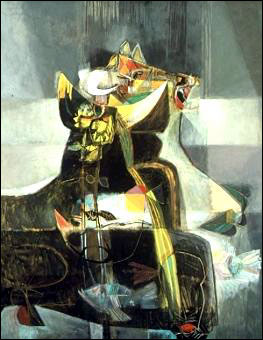Museo Nacional de Colombia,
Oct 19, 2001 - Jan 13, 2002
Bogotá, D.C., Colombia
Alejandro Obregón
by Carmen María Jaramillo
The Pictorial Space
The artist's need to break with tradition, as well as the renewal provided by his work, added to Colombian culture. He did not start off from his adherence to groups or the writing of manifestos. He made a statement published in 1955, in which he summarizes his position and fundamental values, undoubtedly imbibed with the artistic beliefs of his time. "I do not believe in schools of painting; I believe in good painting, and that is all. Painting is an individual expression, and there are tendencies as there are personalities. I have admired good painters - especially the Spanish ones - but I believe that none of them has decisively influenced my training." (2) In this statement, his powerful anti-scholarly attitude may be perceived, as well as his need for originality leading him to reject influences and reinforce his style."
Alejandro Obregon's work broke the conception of the pictorial space that was predominant in the national arena before he appeared. In his works of the '50s, the artist investigated new ways of accessing space. Therefore, his interest in what appeared to be Cubism was due to the search for new possibilities of building space, rather than the adoption of the principles governing such movement.
Further on in his mature works, the painter created a space that broke with the structure of linear perspective and was part of a spatial concept that recalled pre-Columbian imagery, archaic and hieratic. Fragmentation of the pictorial space also enabled him to join several ideas from which he created a new meaning.
Nature, Geography, Landscape
Once the singular pictorial space was established, he created a new view of the Colombian landscape. An incomparable colorist, his painting turned symbolic and he referred to the Caribbean and the Andes as places that merge different times and cultural expressions. Landscape, as a contemplative vision of nature that had prevailed in Colombian art even during the first half of the 20th century, is revisited in his production, and he creates a new relationship between landscape and culture.
Obregón works on the concept of nature as power and beginning. In this way, every object of inspiration took on a symbolic dimension. Thus, his painting may speak of the Caribbean or the Andes, but it may also be the subject of the most diverse readings. As a means of explaining this, the condor - one of his most repeated symbols - may refer to the American wildlife, and also to a geography linking different times and cultural expressions.
Political Context
In order to understand the relationship between art and the political context in Obregón's work, it is necessary to explore the artistic circumstances of the moment. In fact, the new painters and sculptors were more engaged with cultural and environmental issues than with political events. Likewise, the adoption of new esthetic concepts and the proximity to an international artistic concept prevented him from carrying on the ideological statement and the language of Americanist artists, whose more significant contributions to Colombian art so far, had been made before the 1940's.
During his early production, Obregón's colleagues formed the same generation that focused, in general, on an esthetic rather than a political revolution. This is why the work of most of them does not refer to the country's bleeding in those times, by virtue of liberal-conservative violence. Nevertheless, the case of Obregón in this aspect is still unique. His work, as well as dealing with an esthetic revolution, pointed at a political reality. His works The Dead Student (1957) and Mourning for a Student (1957) refer to events that occurred during Roja Pinilla's government. Violence (1962), one of the milestones of the history of Colombian art, evidences one of the most bloodiest periods of the 20th century in the country, and his Homage to Camilo (1968), also denotes a time in which they had passed from the liberal-conservative opposition to the left-right extremes at the end of the '60s. Except for some of Enrique Grau's works and some engravings by Rengifo and Hanné Gallo, Obregón's colleagues of his same generation devoted themselves to renewing plastic arts and, only at the end of the '50s, did they return to the American territory, more focused on the pre-Columbian world than on contemporary conflicts.
Nevertheless, Obregón's work is far from a political militancy or the illustration of an ideology. Above all, his work establishes a reading from a plastic point of view. Marta Traba, one of his greatest admirers who stated he was the one who started modern painting in Colombia, referred to his work Violence in this way; "It is an idea which has resulted in painting. This is why the term 'committed work' does not correspond to it at all, since this is the name given to painting which makes a commitment with something which is different from itself." (3)
We might conclude that in Obregón, the sensitive approach to the environment does not clash with his work's meaningful possibilities; with this integration and its redefinition of the pictorial space and the landscape, one of the most wonderful productions within Colombian art is achieved.
Read Artist Biography
|









